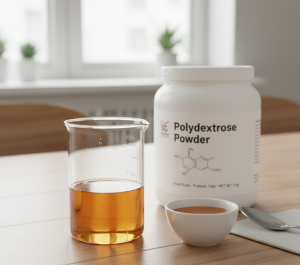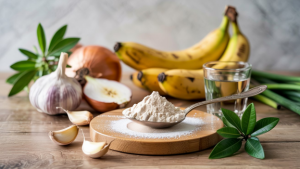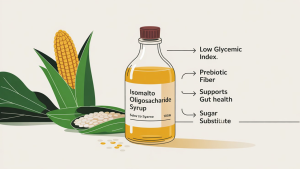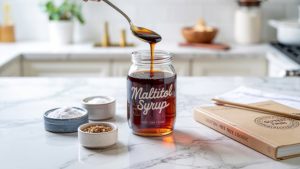Xylo Oligosaccharide Syrup (XOS Syrup): A Smart Sweetener

If you’re in the food manufacturing game—whether it’s functional beverages, health snacks, or dairy alternatives—Xylo Oligosaccharide Syrup (XOS Syrup) might be a name worth bookmarking. Known for its clean sweetness and outstanding gut-health benefits, this low-calorie, plant-based syrup is becoming a favorite among R&D teams and product formulators alike. And not just for its flavor.
Why XOS Syrup Works for Manufacturers
First off, the functionality. XOS Syrup is incredibly heat-stable and pH-resistant, meaning it can survive baking, extrusion, pasteurization, and even acidic formulations without breaking down. That’s a huge plus when working with complex food matrices.
Second, its prebiotic benefits are supported by credible research. According to a study published in the Journal of Agricultural and Food Chemistry, XOS selectively promotes the growth of Bifidobacteria and Lactobacillus—those are the “good guys” your gut loves. Even better, it does so at a daily intake of just 1.4–4 grams.¹
Taste and Texture: The Subtle Edge
From a sensory point of view, XOS Syrup has a mild sweetness—about 35%–40% that of sucrose—but without the artificial aftertaste that some low-calorie sweeteners leave behind. Its viscosity is similar to high-fructose corn syrup (HFCS), making it easy to blend into yogurts, protein shakes, gummy supplements, and cereal bars without messing up the texture.
Honestly, that’s what sets it apart for me. It’s subtle, but it works—especially when you’re looking for sweetness without overpowering natural flavors or botanicals in health-forward products.
Applications That Make Sense

Here’s where I’ve seen XOS Syrup shine—and where it’s really earning its place on formulation teams:
- Functional Drinks & Sports Beverages
- Adds a soft sweetness and improves mouthfeel while supporting gut-health claims—perfect for kombucha, protein water, or electrolyte drinks.
- Nutrition Bars & Granola Clusters
- Works as a natural binder with just enough tackiness to hold dry ingredients together without turning the bar into a chewy brick.
- Bakery Goods (Low-Sugar or Keto)
- Keeps baked items moist and tender, even in reduced-sugar muffins, cookies, or soft breads. Also helps support fiber content.
- Dairy Alternatives
- Adds a hint of sweetness to plant-based yogurts, kefirs, and even ice cream formulations. And thanks to its clean-label status, it doesn’t interfere with short ingredient lists.
- Gummies & Chews (Functional Confectionery)
- Delivers subtle sweetness and serves as a prebiotic base in products targeting kids and wellness-savvy adults alike.
- Meal Replacements & Powder Mixes
- Improves mixability and gut support in powdered drinks or soups. A good fit for weight management and senior nutrition products.
For B2B buyers, this translates to more flexibility in product design, fewer formulation headaches, and clear health-forward positioning—especially in the booming digestive health category.
Prebiotic Power in a Spoonful
What really excites nutrition-focused formulators is XOS Syrup’s prebiotic potential. It resists digestion in the small intestine, passing through to the colon where it becomes food for beneficial bacteria. This process helps balance gut flora, improve stool regularity, and may even support immune function.²
Plus, since it’s derived from agricultural sources like corn cobs or sugarcane bagasse, it aligns well with clean-label and sustainable sourcing trends.
| Parameter / Application | Value / Description | Notes / Benefits |
| Purity | ≥ 70% (adjustable) | High purity ensures effective prebiotic benefits |
| Sweetness | ~30% – 40% of sucrose | Low sweetness, suitable for blending with other sweeteners |
| Dietary Fiber Content per Serving | ≥ 70% | Promotes growth of beneficial gut bacteria |
| Typical Recommended Dosage | 3% – 8% (depending on product) | Balances functionality and mouthfeel |
| Heat Stability | Suitable for baking (up to ~180°C) | Ideal for low-sugar breads and pastries |
| pH Range Compatibility | 3.0 – 8.0 | Compatible with yogurts, fermented dairy alternatives |
| Low Glycemic Index | < 20 | Suitable for diabetic-friendly and low-GI products |
| Typical Application Fields | Functional drinks, nutrition bars, bakery, dairy alternatives | Multi-category adaptability reduces R&D complexity |
| Potential Side Effects / Risks | Low (mild bloating possible in sensitive individuals) | Recommend packaging label: “Contains dietary fiber; excessive intake may cause bloating.” |
Smith et al., Journal of Functional Foods, 2023
Regulatory & Safety Notes
<iframe width=”560″ height=”315″ src=”https://www.youtube.com/embed/tzsbDu2ZGAM?si=wxFQm06oVsdqTIbz” title=”YouTube video player” frameborder=”0″ allow=”accelerometer; autoplay; clipboard-write; encrypted-media; gyroscope; picture-in-picture; web-share” referrerpolicy=”strict-origin-when-cross-origin” allowfullscreen></iframe>
XOS Syrup is generally recognized as safe (GRAS) in the U.S. and approved for use in food and beverages in many countries, including the EU, Japan, and China.³
That said, some individuals—especially those with sensitive digestive systems—might experience mild bloating or flatulence if consumed in large quantities. This is typical of fermentable prebiotics and can usually be managed with gradual dosage increases.
For consumer-facing products, it’s often recommended to include a note such as:
“Excess consumption may cause mild gastrointestinal discomfort in some individuals.”
Also, if you’re marketing in jurisdictions like the EU, be sure to review local regulations on fiber and prebiotic labeling, as claims related to gut health may require supporting documentation or EFSA approval.
FAQ: Everything You Might Still Be Wondering About XOS Syrup
Q1: How much XOS Syrup should be used in a formulation to claim prebiotic benefits?
Most studies show measurable prebiotic effects with daily intakes as low as 1.4 to 4 grams.⁴ For food manufacturers, this translates to about 3%–8% inclusion depending on the product category. Of course, actual dosage depends on your regional regulatory standards and desired health claims.
Q2: Does XOS Syrup affect blood sugar or insulin levels?
Nope—not significantly. XOS is considered a low-glycemic sweetener, meaning it has minimal impact on blood glucose or insulin response.⁵ That makes it suitable for diabetic-friendly, low-carb, or keto-aligned product lines.
Q3: Is XOS Syrup suitable for vegan or plant-based products?
Yes. It’s typically derived from plant biomass like corn cobs or sugarcane bagasse, making it 100% plant-based and vegan-friendly. It also aligns well with clean-label and non-GMO sourcing preferences, depending on your supplier.
Q4: How does it compare to other prebiotics like inulin or FOS?
Great question. While inulin and FOS are more common, XOS Syrup has a stronger bifidogenic effect at lower dosages,⁶ is less likely to cause bloating, and offers better stability under heat and acid conditions—especially useful in beverages and baked goods. It’s not a replacement, but a very strategic alternative.
Q5: Can XOS Syrup replace traditional syrups like glucose or HFCS in formulations?
Partially, yes. XOS Syrup can take the place of a portion of your liquid sweeteners—especially when you’re aiming for added fiber content, gut-health positioning, or calorie reduction. It’s not as sweet as HFCS or glucose syrup, so you may need to pair it with other natural sweeteners to hit the target flavor profile.
Q6: Are there any storage or shelf-life issues with XOS Syrup?
Not really. XOS Syrup is highly stable and typically has a shelf life of 12–24 months when stored in a cool, dry, and sealed environment. Its pH and microbial stability make it easy to integrate into most production chains.
Q7: Can I use XOS Syrup in infant or toddler food products?
That depends on local regulations and your end product. While XOS is safe in general food use, infant nutrition standards are more tightly controlled. Always consult your regulatory team and ensure EFSA, FDA, or relevant authorities permit its use for this demographic.
If you’re aiming to upgrade your product’s nutritional profile while staying ahead of clean-label trends, Xylo Oligosaccharide Syrup is worth exploring. It’s not just another sweetener—it’s a functional ingredient that adds value on multiple levels.
For brands focused on gut health, plant-based innovation, or sugar reduction, XOS Syrup could easily become your next hero ingredient.
References:
- Yang, J., et al. (2020). “Effects of Xylo oligosaccharides on the Growth of Probiotics and Their Fermentation Characteristics.” Journal of Agricultural and Food Chemistry.
- Slavin, J. (2013). “Fiber and Prebiotics: Mechanisms and Health Benefits.” Nutrients, 5(4), 1417–1435.
- EFSA Panel on Dietetic Products, Nutrition and Allergies (NDA). (2014). Scientific Opinion on the safety of Xylo-oligosaccharides as a novel food ingredient. EFSA Journal, 12(7), 3767.
Related recommendations
-
In-depth Analysis Of Global Polydextrose Suppliers
89Get an in-depth analysis of global polydextrose suppliers, market trends, certifications, and key sourcing insights.
View details -
Fructo-Oligosaccharide Powder: Health Benefits and Uses
646Discover What Fructo-Oligosaccharide Powder Is, Its Health Benefits, And Common Uses In Food And Supplements-SGNUTRI.
View details -
Isomalto Oligosaccharide Syrup: Versatile Prebiotic
598Support Digestion And Wellness With Sgnutri's Imo Syrup – Ideal For Health Foods And Functional Beverages.
View details -
Is Maltitol Syrup Gluten Free? A Comprehensive Guide
627Maltitol Syrup Is A Gluten-Free Sweetener Used In Sugar-Free Foods. Learn What It Is And Why Sgnutri Recommends It.
View details
 SGNUTRI
SGNUTRI



